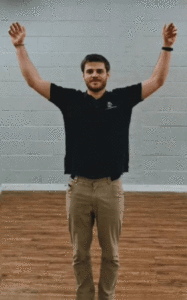Most climbers have heard of antagonist training. And once they reach a certain level most climbers know they should be doing it.
But not a lot of climbers really know what it is…
Something about opposing muscles and reducing injury… or antagonising trains?
What is antagonist training?
Muscles in the body generally come in agonist-antagonist pairs to ensure that we can move efficiently. We give the term agonist to the muscle that is contracting to generate a specified movement, while the antagonist is relaxing to allow that movement to happen.
The simplest example to think about is flexing your arm. When flexing, your bicep contracts and shortens to produce the movement, while your triceps relaxes to allow the movement to happen. So your bicep acts as the agonist and your tricep is the antagonist.
Throughout the body, you find joints are controlled by pairs of muscles collaborating in opposition to produce efficient muscles. Most joints aren’t as simple as that of the elbow, and so you find more complex networks of muscles interacting, but the basic premise remains the same.
So what does that have to do with climbing?
Well, climbing is a fairly one-sided sport. What I mean by this is that we rely heavily on one-half of these agonist-antagonist pairings. We use our wrist and fingers flexors for gripping much more than our extensors, our shoulder internal rotators and adductors and rarely our external rotators and abductors.
Essentially we do a lot of this:

And not a lot of this:
(Oversimplification, but you get the point. Plus, GIFs)

So the idea of antagonist training is to add these complimentary movements back into our training.
Why bother?
It’s generally not a good idea to become too unbalanced, and common wisdom among coaches and therapists alike is that a well-balanced muscular system is likely to lead to fewer injuries and improve overall performance. This is just a prevalent idea that almost everybody has heard of muscular imbalances – with everybody in fitness fearing their injury-causing effects.
As far as I am aware, the evidence for this claim in the literature is actually pretty sparse. Here’s a quote from one review of the evidence in professional football (one of the most researched areas in sport, because money):
“The overall level of evidence for muscle imbalance is inconclusive as research findings are limited and contradictory.”
While that same study did go on to mention certain imbalances that had been found to increase injury risk, overall there just wasn’t enough evidence to support a definitive claim that muscle imbalance leads to greater to injury risk.
But lack of research evidence doesn’t necessarily mean there’s no validity to the claim. There is good logical reason to assume that severe imbalance will lead to an increased risk of injury, and the experience of many coaches and therapists seems to back this up.
Despite this, there is good reason to believe that training variation and increased movement literacy will lead to increased performance, while at the same limiting the risk of overloading yourself in one specific area. The idea is that if your body is better at spreading your training load effectively, then one tissue won’t keep taking too much load and fail.
So including antagonist training alongside other activities like yoga, running or cycling is probably a good move for every climber.
But what to include?
Google antagonist training for climbers (as you probably have) and you’ll find that there are quite a few guides out there. Some of these are incredibly thorough. My problem with the ones I’ve found is the sheer number of exercises recommended.
Antagonist training will only ever be a secondary consideration for climbers, so what I’ve compiled here the select few most important antagonist exercises that all climbers should include. Nothing more, nothing less.
Of course, there will be others that elite climbers and those on competition training programs should be doing. But they’re just not necessary for the VAST majority of recreational climbers. Even those training up to 5-6 times per week.
PIKE PUSH UP
Climbing is pretty much all pulling. We pull ourselves upwards. We pull slowly and with control, or we pull explosively (and also with control, hopefully).
Apart from mantling and palming off, we don’t do any pushing. So any pushing exercise is going to work wonders when it comes to re-balancing your body.
I particularly like the pike push up, for a number of reasons. Firstly, it doesn’t require any equipment so you can do them anywhere, even at the crag. Secondly, it’s an overhead pressing movement, so acts in direct opposition to most of the pulling we do. And thirdly (and here comes my training bias) it is a regression of the handstand push up, so has almost endless scope for progression while inadvertently learning a pretty cool movement skill!
Never seen the pike push up before? Well here’s how to do it:
Alternatives: this is quite a hard push up variation I’ll admit, so please feel free to start with a regular push-up and build up from your knees if necessary. If you want to switch things up, or simply don’t like push-ups, and prefer the feeling of lifting weights, then a kettlebell or barbell military press is for you.
Reps: 8-12 for general strength-endurance, 3-5 if you really want to get stronger at it.
SHOULDER EXTERNAL ROTATION/SCAPULA ANGELS
As I mentioned earlier, in climbing we get pretty good at strengthening the powerful internal rotators of the shoulder, primarily our pecs and our lats. But we almost never work our external rotators (which are much smaller muscles in the first place) or the muscles in our upper back which draw our shoulder blades back.
This imbalance is the primary cause of the infamous “climber’s hunch” – that rounded upper back and shoulders that is all too common amongst seasoned climbers.
This exercise is my single favourite exercise to hit all of these muscles in one go. And all you need is an elasticated band (I’d advise any and every climber to get a set to ensure you can keep progressing as you get stronger).
Here’s how it’s done:
Alternatives: here’s another great exercise for strengthening up the rotator cuffs of your shoulder. The trick with this one is in getting the form right. You know it’s right when everything is burning. If you find this exercise easy, you’re doing it wrong.
Reps: 8-12 is a good amount for these
WRIST ROTATIONS (FOR THE ELBOW)
Our poor elbows take a bit of a battering when climbing. All of the powerful muscles which keep our fingers gripped against the wall extend down from the elbow, so a lot of load goes through that knobbly little joint.
Making sure your shoulders are strong and mobile is the first priority when it comes to protecting your elbows. So, if you’re strapped for time, focus on the shoulder exercises above.
If you’re committed to keeping your body in good working order (or have previously experienced golfer’s or tennis elbow and so have all the motivation you need) then this exercise is a great option.
All you need is a dumbbell with weight on one side, or a hammer, or a wine bottle.
Here’s how it’s done:
Alternatives: here’s another good exercise to help strengthen your wrist. It’s not exactly an alternative to the one above, but an added bonus.
Reps: 10 on each arm is a solid place to start
FINGER EXTENSIONS
And now for the classic that everyone knows and loves. No climbing antagonist routine would be complete without finger extensions!
As I’ve mentioned above, although our finger extensors are involved in pinching and stabilising the wrist when we climb, we use our finger flexors a hell of a lot more.
So to keep things balanced, get an elastic band or a specific finger extension tool (google finger extension) and get to it.
Reps: 15-20. Your fingers are working all the time so you need to match them for endurance.
Is that all?
Those are, in my eyes, the most important strengthening exercises for climbers to supplement into their training to keep their bodies balanced and reduce risk of injury.
What we haven’t touched on here are any specific lower body exercises for climbers. You can find my take on these in a separate blog (COMING SOON).
The same goes for flexibility. Climbing is one sport where flexibility is a real asset, and I have a blog detailing the most important areas to focus on (COMING SOON). This is particularly important in the upper back and shoulders, as not having the mobility required to get your arms overhead comfortably can compromise your shoulder joint and elbows.
If you have any questions about any of the above or would like some assistance with programming or coming back from an injury then please don’t hesitate to get in touch.